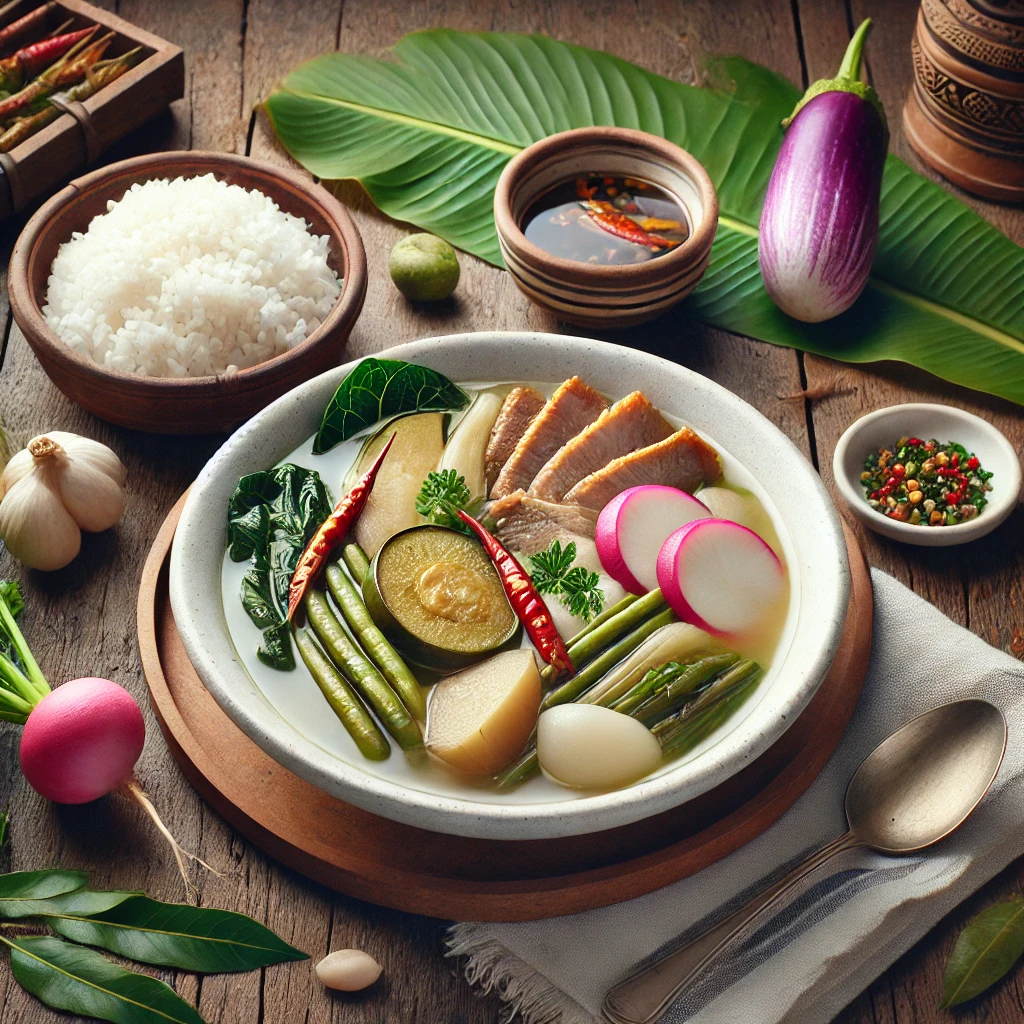A Classic Filipino Dish Perfect Sinigang

What is Sinigang?
- A Brief History of Sinigang
- Origins of the dish in Filipino culture.
- Why Sinigang is a Staple in Filipino Cuisine
- Its unique sour flavor and comfort food status.
Types of Sinigang Variations
- Sinigang na Baboy (Pork Sinigang)
- The most popular version.
- Sinigang na Hipon (Shrimp Sinigang)
- A seafood twist.
- Sinigang na Isda (Fish Sinigang)
- Perfect for a light meal.
- Vegetarian Sinigang
- A plant-based alternative.
Key Ingredients for Sinigang
- Proteins for Sinigang
- Pork, shrimp, fish, or tofu.
- Vegetables That Complement Sinigang
- Radish, kangkong, tomatoes, and okra.
- The Star of Sinigang: Tamarind
- How tamarind creates the sour taste.
- Substitutes for Tamarind
- Alternatives like calamansi, green mango, or Sinigang mix.
Step-by-Step Sinigang Recipe
- Ingredients Needed
- A detailed list of ingredients for pork sinigang.
- Cooking Instructions
- A step-by-step guide to making Sinigang.
Tips and Tricks for Perfect Sinigang
- Balancing the Sourness
- Adjusting tamarind or mix to taste.
- Adding Spices for Depth
- Enhancing flavor with chili or ginger.
- How to Avoid Overcooking Vegetables
- Keeping them fresh and vibrant.
Perfect Sinigang Pairings and Serving Suggestions
- H3: Best Side Dishes for Sinigang
- Rice, fried fish, or crispy pork.
- H3: Drinks to Complement Sinigang
- Traditional Filipino beverages or wines.
Nutritional Benefits of Perfect Sinigang
- Packed with Vitamins and Minerals
- Nutritional value of the vegetables.
- Low-Calorie, High-Flavor Meal
- Great for healthy eating.
Frequently Asked Questions About Perfect Sinigang
- Can I freeze leftover Sinigang?
- How can I make Sinigang less sour?
- What’s the best way to reheat Sinigang?
- Are there regional variations of Sinigang in the Philippines?
- Can I use other souring agents apart from tamarind?
How to Make the Perfect Sinigang: A Classic Filipino Dish
What is Sinigang?
Sinigang is a quintessential Filipino dish celebrated for its tangy, comforting flavors. Known for its signature sourness, it’s a versatile soup that can be adapted with different proteins and vegetables. Whether you’re cooking for a family meal or introducing Filipino cuisine to your friends, Sinigang is sure to impress.Perfect Sinigang
Types of Perfect Sinigang Variations
Sinigang na Baboy (Pork Sinigang)
This version is a crowd favorite, featuring tender pork ribs or belly simmered in a rich, sour broth.
Sinigang na Hipon (Shrimp Sinigang) Perfect Sinigang
Perfect for seafood lovers, this variation uses fresh shrimp for a lighter, more delicate flavor.
Sinigang na Isda (Fish Sinigang)
This is an excellent choice if you prefer a healthier, low-fat option. Popular fish options include milkfish or tilapia.Perfect Sinigang
Vegetarian Sinigang
For a plant-based take, you can swap out meat for tofu or mushrooms, retaining the classic Sinigang taste.
Key Ingredients for Sinigang
Proteins for Sinigang
You can use pork, shrimp, fish, or even chicken. The choice of protein determines the richness of the broth.
Vegetables That Complement Sinigang
Traditional vegetables include radish, eggplant, kangkong (water spinach), tomatoes, and okra.
The Star of Sinigang: Tamarind
Tamarind is the key to Sinigang’s sour flavor. You can use fresh tamarind pods or tamarind paste.
Substitutes for Tamarind
If tamarind isn’t available, try using calamansi juice, green mango, or a store-bought Sinigang mix for convenience.
Step-by-Step Sinigang Recipe
Ingredients Needed
- 1 lb pork belly or ribs
- 8 cups water
- 2 medium tomatoes, quartered
- 1 medium onion, sliced
- 1 cup fresh tamarind (or 2 tbsp tamarind paste)
- 1 cup radish, sliced
- 1 cup eggplant, sliced
- 1 cup kangkong leaves
- 1 cup string beans
- Salt and fish sauce to taste
Cooking Instructions
- Prepare the broth: Boil water in a pot. Add the pork, onion, and tomatoes. Simmer until the pork is tender.
- Add tamarind: Mash fresh tamarind in a separate bowl with hot water to extract the juice. Strain and pour into the pot. Alternatively, add tamarind paste.
- Season the soup: Add fish sauce and salt to taste. Adjust the sourness by adding more tamarind juice if needed.
- Cook the vegetables: Add radish, eggplant, and string beans. Simmer until slightly tender.
- Finish with greens: Add kangkong leaves just before turning off the heat to retain their freshness.
- Serve and enjoy: Pair with steamed rice for the best experience.
Tips and Tricks for Perfect Sinigang
- Balance sourness with a hint of sweetness from ripe tomatoes.
- Avoid overcooking vegetables to keep them vibrant and crunchy.
- Add chili for a spicy kick if desired.
Sinigang Pairings and Serving Suggestions
Sinigang is best enjoyed with freshly steamed white rice. Pair it with crispy fried fish or grilled meats to complement the tangy broth.
Nutritional Benefits of Sinigang
Sinigang is packed with nutrients from the vegetables and protein. It’s low in calories yet rich in flavor, making it a healthy comfort food option.
FAQs About Sinigang
- Can I freeze leftover Sinigang? Yes, store it in an airtight container and freeze for up to a week.
- How can I make Sinigang less sour? Use fewer tamarind pods or dilute the soup with more water.
- What’s the best way to reheat Sinigang? Heat it on the stove over low heat to preserve the vegetables’ texture.
- Are there regional variations of Sinigang in the Philippines? Yes, some regions add unique ingredients like guava or miso.
- Can I use other souring agents apart from tamarind? Absolutely! Calamansi, green mango, or even lemons can work.
Enjoy this delicious and heartwarming Filipino dish!


